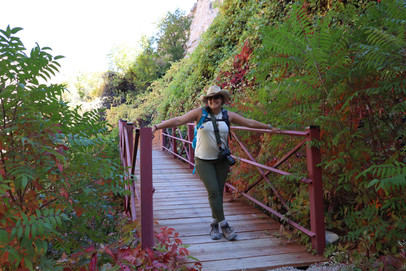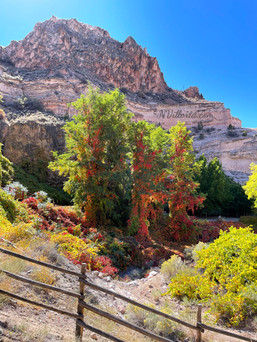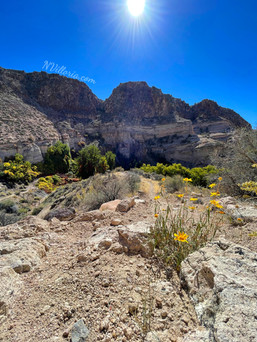Kershaw-Ryan State Park; Hiking an Impressive Desert Oasis
- Nikki Emord
- Nov 15, 2022
- 4 min read
Updated: Aug 17, 2024
Day two of our trip to Cathedral Gorge State Park included more than just a simple road trip back to the city, in fact it included an amusing hike and checking off another state park.
Having already returned from our short drive through Pioche, and returning south, we took the short 22-minute drive from Cathedral Gorge and headed to Kershaw-Ryan State Park.
Skimming the outskirts of Caliente, NV, we drove past the Caliente railroad depot and merged onto the NV-317 before making our way onto the park’s entrance road. After showing our park pass and grabbing a trail map, a small 16-unit campground situated near the entrance, with plenty of available spots, immediately enticed us to add the park to our list of considerations for future camping options. Having just driven amongst a combination of farmland and desert landscape, once through the park’s entrance gate I expected much of the same type of scenery we had already witnessed over the past 48-hours. As a result of my expectations, I was thrilled and in awe of the oasis that unfolded in front of us as we reached the main parking lot. A sharp contrast to the desert landscape surrounding the area, the park’s sprawling lawn and garden of wild vines, oaks, fruit trees and willows was a garden dreams are made of.

Established in 1873 by the Kershaw family, this land was developed into an orchard and garden and was referred to by local residents at the time as the “Kershaw Gardens.” Sold to the Ryan brothers, in 1904 the land remained in the Ryan’s ownership until 1934 when they donated the Kershaw Gardens to the state of Nevada for use as a public park. Tables, fire pits, outhouses, a wading pool and a caretaker’s cabin were immediately constructed and in 1935 the land was officially dedicated as Kershaw Canyon-Ryan. By 1961 Kershaw-Ryan had become a full-service park and included a number of additions, such as the campground we had passed on the way into the park.
Over the years the park has yielded to the natural weather patterns that this part of the state brings, being shut down in 1984 by a flash flood that demolished most of the park and its amenities. After much reconstruction and redesign the park reopened in 1997 and now continues to flourish as a hidden gem nestled in Lincoln County’s windswept desert.
Once parked, we evaluated the available hiking trails and walked through the initial park grounds, taking in the beauty of sprawling vines, deciduous trees, rose bushes and flowers. Not only was I captivated by the gardens, themselves, I was also amazed at the number of amenities the park had available. From a small spring-fed wading pool to volleyball courts, horseshoe pits and a playground, not to mention the ample picnic areas and impressive grilling arrangements.
What made this little oasis even more remarkable to see was how it contrasted so much to the encompassing canyon and desert landscape that intertwined with it; a beautiful juxtaposition of scenery.
Walking over a short wooden bridge and crossing through a an archway of wild grapevines, we made our way out of the oasis and emerged into the surrounding desert landscape. We then proceeded to head to the dirt trails for a little bit of hiking, before we ended our adventures and headed home.
Heading up the Canyon Overlook Trail, we reached a trail crossroads and deliberated our options. Knowing that the park included a number of hiking and mountain biking trails, but uncertain of which was designated for what, standing at the intersection we decided to continue on the Overlook Loop and choosing to go further into the desert rather than head back, we were soon met with a vertical incline trail to traverse on crumbling gravel and soft dirt. For the next 200 or so feet of elevation gain, we’d slow your pace every few feet to catch our footing or our breath and comment that we were grateful we were hiking up and not down, and that you’d have to be crazy to try to bike this.
Making us earn our view at the top, we finally peaked the canyon rim and were greeted by the trails’ signage, “Skidsteer.” Appropriately named, I later learned that this portion of the trail was in fact a 250-foot black diamond trail for mountain biking. Letting our legs find foundation on solid ground, allow our heart rate to recover from the climb, and taking some time to enjoy the incredible views at the top, we had a snack and snapped some photos of the canyon and enclosed oasis below.
Deciding that it was about time to head back to Vegas, we took a series of bike and hiking trails back to the truck. From our lookout atop of Skidsteer, we took the Mesa Cutoff trail to the Kershaw Redemption Loop, which eventually hooked back up to the Overlook loop and back toward the truck, descending from desert high grounds, back into the lush garden of vines and trees.
All-in-all Kershaw-Ryan contains 14 miles of established hiking and mountain biking trails and although we had only completed a short 1.5-miles of hiking for the day, it was the perfect introduction to the park and what it has to offer.
Packing our hiking bags into the truck and pulling out of the parking lot we confirmed that this was one park we would definitely be bringing our mountain bikes to for a future visit, although I can say with absolute certainty that Skidsteer will not be on the biking agenda.























Comments